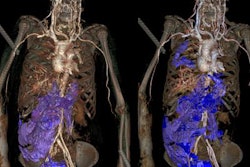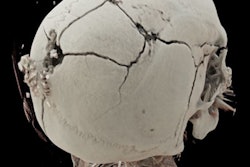
The creator and organizer of a series of special exhibitions at ECR, Dr. Hermann Vogel, died on 30 July at the age of 76. A recognized international expert in forensic imaging, he made over 40 trips to war zones and areas of crisis across the globe to investigate human rights abuses.
Vogel was head physician and professor of radiology at the Albers-Schönberg-Institute, St. Georg Hospital in Hamburg, Germany. He digitized and archived over 1,500 x-rays of violence, torture, and terrorism obtained during his visits to Vietnam in 1976, Mexico in 1978, and then to Zimbabwe, South Africa, Chile, Croatia, Turkey, and other countries.
 Vogel wore his trademark check jacket at regular ECR exhibitions. Image courtesy of Dr. Adrian Thomas.
Vogel wore his trademark check jacket at regular ECR exhibitions. Image courtesy of Dr. Adrian Thomas."I was always struck by his friendliness and his cheerful manner," recalled Dr. Adrian Thomas, consultant radiologist at South London Healthcare National Health Service (NHS) Trust in Bromley, U.K., and author of AuntMinnieEurope.com's history column. "At his fascinating ECR exhibitions, in cooperation with the Deutsches Röntgen Museum, he was always to be seen talking enthusiastically to anyone who showed an interest in the display."
Born on 1 July 1942, Vogel contributed in many areas of radiology, was much in demand for his opinion, and he presented many courses, lectures, and exhibitions internationally. He had a real passion for the history of radiology.
"I was always surprised by how active he was, and his energy and industry would put many younger men to shame," Thomas noted. "I will miss my friend."
Military radiology
Thomas said he particularly enjoyed Vogel's compelling presentation about King Henry IV of France, whose head was lost when revolutionaries desecrated his grave. Also, Thomas was very impressed with Vogel's book about the first 50 years of military radiology (1895-1945), which was published to coincide with ECR 2008.
His exhibitions were published in different languages, including German, French, Polish, Arabic, and English, and were shown throughout the world. At ECR 2009, for instance, Vogel's exhibition focused on forensic radiology, concentrating on the living as well as the dead, and featured more than 20 posters, including many thought-provoking images.
"Living people are searched for drugs and weapons, and dead people are examined to determine the cause and circumstances of their death. Forensic radiology is applied for the reconstruction of accidents and to prove crimes," he wrote in the accompanying pamphlet. "It has become evident that the combination of diagnostic imaging and forensic medicine solves more cases of death of unknown cause than each alone, and that a radiograph can be read like a document describing forces of modern time and its effects on current society."
Abuse and torture
 The book Vogel wrote with B.G. Brogdon and John McDowell.
The book Vogel wrote with B.G. Brogdon and John McDowell.Along with B.G. Brogdon and John McDowell, Vogel wrote the classic textbook about the radiology of abuse, torture, terrorism, and inflicted trauma, which included over 700 large radiographs related to clinical forensic medicine and the detection of concealed arms, explosives, and other weapons. It gave details about the latest modalities for evaluation and identification of victims, and included more than 30 color photos and specimens with virtual autopsy radiographs from MRI and CT.
"The results of aggression against humans can be hideously obvious, but may also be entirely concealed from casual inspection," the authors noted. "Often, only exploration of the hidden recesses of the mind via psychiatric evaluation, or radiologic exploration of the inner recesses of the body, can reveal the evidence of such violence. This book focuses on the latter."
An article with the headline "Traces of torture" was published on 15 December 2009 by the German newspaper, Hamburger Abendblatt, and went into great detail about Vogel's work:
With his SLR camera, he photographed in military hospitals and x-ray archives of the clinics. He was often on his summer vacation. Several times he photographed slides in hotel rooms against the light on the ceiling. Other documents he received from rehab centers for torture victims in Berlin, Paris, Copenhagen, and Stockholm, and foreign colleagues who knew that he collects such recordings. "I see misery that differs from the daily pain in the clinic, it's suffering people have caused to people," he says. "It's disgusting, you cannot just look the other way."
It is very difficult to get pictures, and most of the time the regime wants to cover up all evidence of torture and violence, including injuries from mutilations, shotguns, and electric shocks, the article continued.
What rulers want to keep secret, Vogel can expose with his pictures ... but the evidence is often hidden. Water torture, solitary confinement, or sexual abuse are the perfidious methods of modern torturers. In some cases it is impossible for Vogel to diagnose the effects of violence. There is no trace, even under the skin. Whether a war is just or unfair, many would always have an opinion. "But torture is not part of small talk," says Vogel, adding that hardly anything is spoken about the victims of war.
Funeral and donations
The funeral service was held at 2 pm on Friday 10 August at Ohlsdorf Cemetery, Fritz-Schuhmacher-Halle in Hamburg. Vogel's family requested that any donations be sent to the Eric and Gertrud Roggenbuck Foundation (Deutsche Bank AG IBAN DE27 2007 0000 0555 5677 00, BIC DEUTDEHHXXX, Verwendungszweck: Prof. Dr. Hermann Vogel).



















